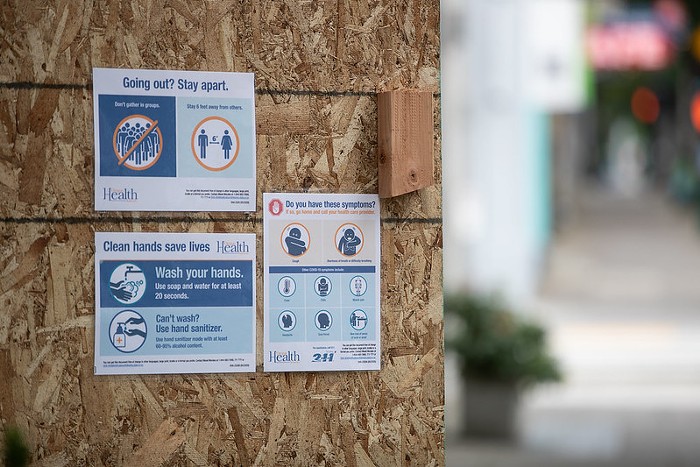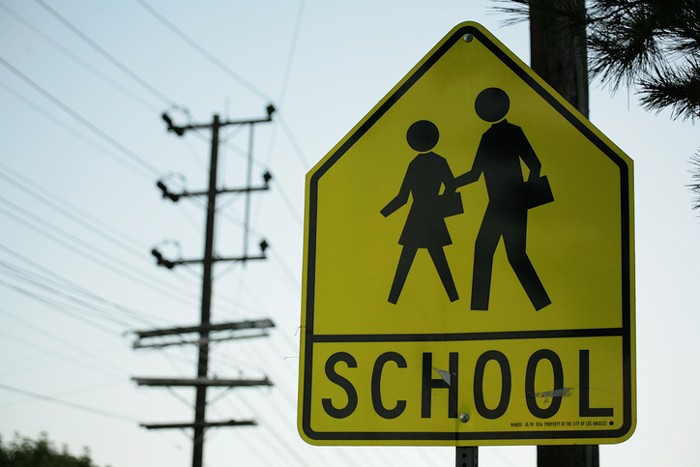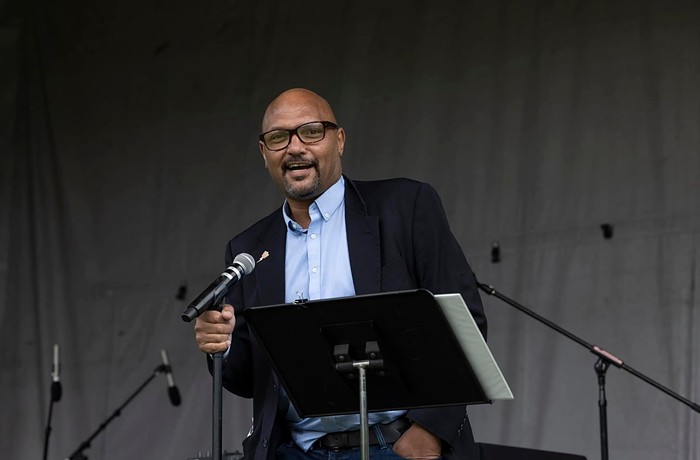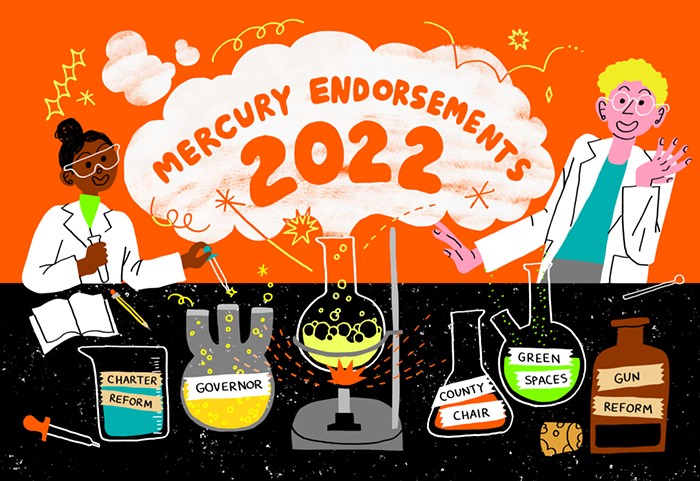
Portlander Samuel Hambrick never learned to drive because he believed cars were too dangerous.
"He was afraid he could hurt someone," his mother, Susan Hambrick told the Mercury.
In September 2021, Samuel was walking along Highway 30 in Northwest Portland in the early morning when he was hit and killed by a person driving a car. The highway doesn’t have sidewalks or a large shoulder, so Samuel—a transit-dependent pedestrian—was walking on the side of the road.
Samuel, who would have turned 35 last month, was one of the 63 people who died in Portland traffic crashes in 2021—the highest number of traffic fatalities recorded in the city in more than 30 years. Of last year’s 63 fatalities, 27 were pedestrians—a significant increase from 2020’s 18 pedestrian deaths out of 54 traffic fatalities and the highest number of pedestrian deaths recorded in 49 years, according to the Portland Police Bureau (PPB).
And 2022 is on track to be even more deadly. Ten Portlanders—six pedestrians and four drivers—were killed by cars in January. This time last year, Portland had only seen four traffic deaths.
Portland’s not alone in its traffic violence crisis. The US Department of Transportation estimated that 20,160 people died in car crashes across the country in the first six months of 2021, the highest number recorded since 2006.
Despite city officials setting a goal in 2015 to see zero fatal crashes by 2025, the city has watched traffic deaths steadily increase almost every year since 2010. Notably, the number of people who report driving as their primary mode of transportation in Portland grew by 46,174 between 2010 and 2019, according to US Census Bureau data.
Transportation safety advocates point to driver speed, car-centric infrastructure, and a lack of holistic community safety investments as reasons for the historic traffic fatalities, citing a need to overhaul the way the city’s transportation system is used and a greater urgency to update car-centric infrastructure.
Slowing It Down
When a driver hits a pedestrian at 20 mph, the pedestrian’s chance of survival is 90 percent, according to PBOT data. At 30 mph, their chance of survival lowers to 50 percent. When hit by a car at 40 mph, a pedestrian has a 10 percent chance of survival.
“As a driver, the difference between 30 and 40 miles per hour doesn’t feel significant,” said André Lightsey-Walker, a policy advisor at The Street Trust—a transportation advocacy organization. “But the result is that 10 miles per hour goes from 50 percent [pedestrian] survival rate to a 10 percent survival rate. I think that’s something we need to continually communicate to people.”
PBOT cites speed as a factor in over half of Portland’s total fatal crashes, and a review of fatal pedestrian crashes between 2017 and 2019 by advocacy group Oregon Walks found speed to be a factor in 75 percent of pedestrian crashes. PBOT doesn’t yet know how many traffic fatalities in 2021 were caused by speeding, because many of the crashes are still being investigated. But, PPB’s Traffic Safety Division reports that speed was a reoccurring factor in fatal crashes last year.
That’s why, in recent years, PBOT has begun lowering speed limits on the city’s 30 high crash corridors—areas in Portland where over half the city’s traffic fatalities occur. The city has coordinated with the Oregon Department of Transportation (ODOT), which oversees speed limit setting throughout the state, to lower speed limits on about 40 miles of Portland streets in 2020 and 47 miles in 2021. That included lowering speeds on 82nd Avenue, NE Glisan, NE Halsey, NE Killingsworth, and 122nd Avenue—all high crash corridors—from 35 mph to 30 mph.
According to the World Health Organization, urban speed limits should not exceed 30 mph to limit fatal crashes. In 2021, 78 percent of Portland’s fatal crashes occurred on streets with speed limits higher than 30 mph. Highway 30, where Samuel Hambrick was fatally hit, has a speed limit of 45 mph.
“Reducing speed is the best way to immediately prevent death on our streets,” Lightsey-Walker said. “There’s tons of ways to [slow drivers down].”
There are other ways the city has tried to slow cars down. In 2021, PBOT added concrete planters in 36 residential intersections connected to “Slow Streets,” a name for the 100 miles of low-traffic neighborhood streets that PBOT blocked off for pedestrians and bicyclists at the beginning of the pandemic. Similarly, the transportation bureau installed raised plastic bumps on 20 intersections throughout the city that force left-turning cars to slow down, giving the drivers more time to see any pedestrians crossing the street. Since PBOT started installing the raised bumps at intersections a few years ago, no pedestrians have died at those intersections. The city will expand both of those programs in 2022.
“Reducing speed is the best way to immediately prevent death on our streets.” — André Lightsey-Walker
PPB has used the increase in speed-related fatalities as evidence the city should increase its budget. In a November press conference, Officer Ty Engstrom of PPB’s traffic division correlated the record number of fatalities to the reduction in police officers patrolling the streets. When Portland City Council removed $15 million from PPB’s budget in 2020, PPB opted to make those cuts in its Traffic Safety Division, leaving Engstrom as the sole member of the team. Engstrom argues that increasing the number of police officers patrolling Portland streets would ramp up speed limit enforcement and decrease the number of traffic fatalities.
National data disagrees with Engstrom. A 2021 analysis of 150 million traffic stops in 33 states showed no correlation between high rates of police stops per mile and a low crash rate per mile.
Lightsey-Walker wants to see greater speed enforcement through automation, not police officers, to prevent racially-motivated traffic stops. Black drivers have long been overrepresented in traffic stops in Portland. While Black people only make up 6 percent of the city’s population, PPB reported that 18 percent of all drivers stopped by police in 2019 were Black.
To more equitably enforce the speed limit, Lightsey-Walker thinks Portland should look to fixed speed safety cameras—cameras that measure vehicle speeds and take a picture when a car is speeding, similar to a red light camera.
Portland has eight speed safety cameras that, according to PBOT, have decreased overall speeding in the nearby areas by 57 percent and caused an 85 percent decrease in drivers going more than 10 mph over the speed limit at those locations.
City Commissioner Jo Ann Hardesty, who oversees PBOT, wants to add additional speed cameras throughout the city. But, Oregon law requires tickets from speed cameras to be processed by sworn police officers and the Portland police say they don’t have the staff capacity to process tickets from additional cameras. Hardesty has partnered with members of the Oregon legislature to introduce House Bill 4105, a law that would allow non-sworn officers to review speed cameras and issue citations. The bill is currently being discussed in committee and has garnered support from the entire Portland City Council, Metro, PBOT, Multnomah County public health officials, and The Street Trust.
“Not only would changing this state law allow us to install far more speed safety cameras throughout Portland, but it will save PPB money and free up resources so more police can be out in the community on patrol and responding to 911 calls instead of stamping tickets,” Hardesty said in a statement. “I’m asking Chief Lovell and the Portland Police Bureau if they will be partners in advocating for this change.”
The PPB did not submit public comment on the bill during the House committee comment period and did not respond to the Mercury's question on whether it supports the bill.
Deprioritizing Cars
Despite PBOT’s continual effort to slow down drivers, Oregon Walks director Ashton Simpson notes that many of Portland’s high crash corridors are long, straight roads with wide lanes that prioritize moving cars quickly from one point to another. In other words, the infrastructure of Portland’s roads facilitates speeding.
“You can reduce the speed on a road, but if a road is designed for speed there's nothing much you can do other than enforce [the speed limit] through automation,” Simpson said. “Ultimately it’s going to take a redesigning of that road or reorganizing.”
As an example, imagine driving a car 50 mph down inner SE Division Street, a buzzing commercial area where each short block is packed with shops, restaurants, and bars, as well as frequent traffic lights. The thin, single-direction lanes feel even narrower when driving past an outdoor seating area in the parking lanes or a sidewalk bump-out where pedestrians are more visible.
Compare that to driving 50 mph down SE 82nd Avenue, an urban arterial with wide, freeway-like lanes and long distances between each traffic light. Most of the adjacent stores have large parking lots and light foot traffic.
Speeding down a street like Division should feel more uncomfortable to drivers because of a design tool called “traffic calming.” Traffic calming uses infrastructure like narrow lanes, speed bumps, medians, and curb extensions to create “a kind of equilibrium among all of the uses of a street, so no one mode can dominate at the expense of another,” according to the Federal Highway Administration.

Both streets have a speed limit of 30 mph, but traffic calming features on Division make drivers aware of how much faster they are moving in comparison to pedestrians and bicyclists. Community members report seeing cars reach highway speeds on 82nd Avenue regularly.
Many of Portland’s high crash corridors are similar to 82nd Avenue—long, straight roads with wide lanes that do little to impede speeding drivers. While there are safety changes that can be made to those roads—like decreasing the distance between traffic signals or adding better lighting for visibility—Simpson believes full street redesigns are essential to solving the root issues.
“It's just going to take a big overhaul of infrastructure and in some places filling in the gaps where [infrastructure] never existed at all,” Simpson said. “There is no short term solution for bad design.”
Bad design to Lightsey-Walker means roads that prioritize car travel over all other modes. For example, 122nd Avenue—an East Portland arterial street—is 85 feet wide. According to Lightsey-Walker, 20 feet are allocated to sidewalks and bike lanes, 14 feet are reserved for parked cars, and 51 feet is provided for car traffic.
“So, 77 percent of [122nd Avenue is] dedicated to cars and I think that’s reflective of our culture,” Lightsey-Walker said. “Our culture invests 77 percent of our infrastructure towards moving a metal box and it tells people that that’s the best way to get around. It doesn’t talk about the consequences of supporting that type of movement.”
Lightsey-Walker believes road design that gives more space to pedestrians and bicyclists would prompt a cultural shift in Portland and help encourage drivers to get out of their cars and into other modes of transportation.
“As long as we can continue to see investments in infrastructure that supports increasing the amount we drive, we will continue to see deaths and serious injuries on our streets,” he said.
Susan Hambrick, whose son was killed on a street without any space allocated for pedestrians, agrees.
“Not everyone drives a vehicle,” Susan told the Mercury. “Roadways need sidewalks, pathways or at the very least, paved or gravel shoulders for pedestrians to utilize.”
PBOT has begun to de-center car travel across the city by adding sidewalk space, protected bike lanes, and pedestrian-focused infrastructure like center medians to projects like the Outer Division Safety Project, the Fixing Our Streets project on 136th Avenue in the Powellhurst-Gilbert neighborhood, and SW Capitol Highway project, all of which were started or completed in 2021.
But PBOT can only make those infrastructure changes on roads it owns. Several of Portland’s high crash corridors, like 82nd Avenue, 122nd Avenue, and Powell Boulevard, are state highways owned and maintained by ODOT. These are the roads that used to cut through farmland to connect urban hubs back when Portland was a smaller city. However, as Portland’s population grew around the corridors, communities started using the state highways, often called “orphan highways,” like city streets. These roads have not been consistently maintained and upgraded for pedestrian safety needs by ODOT because they only serve regional drivers and ODOT prioritizes maintenance for roads that serve the most Oregonians, like Interstate 5.

Those maintenance and safety upgrade delays leave a toll on the community. From 2016 to 2019, ODOT averaged 14 deaths per year on state roads within Portland city limits. In 2021, 32 people—just over half the city’s total traffic fatalities—died on ODOT-owned roads in Portland.
Transportation advocates argue that these orphan highways no longer serve the surrounding communities’ needs and should be redesigned and owned by PBOT. Public agencies only began seriously considering this shift in 2021.
In June 2021, shortly after two pedestrians were struck and killed by drivers on 82nd Avenue, PBOT and ODOT formed a plan to transfer 82nd Avenue to the city.The city and state agreed to complete $185 million in street upgrades as part of transferring the street to the city, including general road upgrades like repaving and updated traffic signals as well possible infrastructure changes like more center medians to reduce left turns, protected bike lanes, and sidewalk bump-outs that disrupt the otherwise straight corridor. PBOT is contributing $35 million, while the state is supplying $150 million to the project. The design changes to the street won’t be determined until after PBOT gains ownership in 2022.
Oregon Walks and the Asian Pacific American Network of Oregon (APANO)—a community group that advocates on behalf of Portland’s Asian community, many who live near 82nd Avenue—will collaborate with PBOT to provide community feedback on how the road could best serve the surrounding community’s needs.
“With ODOT owning 82nd, it’s a highway where speed and freight are prioritized,” said Metro Councilor and associate director of APANO Duncan Hwang. “It’s not in their interest to care as much about the surrounding neighborhoods because it’s not the purpose of that road. It was a mismatch of use and now we’re moving to an agency that has more alignment with how the road is actually used now.”
But 82nd is only one of many orphan highways within Portland city limits. In 2020, Metro—the regional government responsible for the Portland metro area’s growth—identified 11 state-owned corridors in Portland that should be transferred to PBOT. Given 82nd Avenue’s price tag of $185 million, repairing and transferring all 11 state highways to the city could easily cost close to $2 billion.
Simpson believes transferring these highways is a doable feat, pointing to the recent influx of transportation funding Oregon received through the federal infrastructure package. According to ODOT, Oregon has about $400 million in flexible funding from the bill.
“Infrastructure always seems to be slow moving,” Simpson said. “What we need now is a sense of urgency to get these projects done.”
“We're bureaucrats. It takes a while.” — Don Hamilton, ODOT
ODOT spokesperson Don Hamilton said the state agency aims to move quickly on these projects, but is often limited by its own processes. When a traffic problem on a state-owned street is noticed, like consistent speeding on a particular roadway or an increase in pedestrian deaths at an intersection, ODOT must first study the conditions that may contribute to the problem, then study the impacts of adding the safety improvements to the area before actually determining what actions to take. Hamilton said that ODOT is cautious about adding safety improvements to roads without significant consideration beforehand, for fear of inadvertently causing a different traffic problem on the road or adding an ineffective safety device.
“We're bureaucrats,” Hamilton said. “It takes a while.”
Simpson sees urgency in local leaders like Hardesty and state Representative Khanh Pham, who was instrumental in securing state funding to help transfer 82nd Avenue to the city. There is also greater urgency to invest in projects that center community safety and other forms of transportation like public transit and biking over cars because of Oregon’s climate goals, Simpson said.
Oregon aims to reduce state carbon emissions 80 percent below 1990 levels by 2050. With 40 percent of Oregon’s emissions stemming from transportation, getting people out of their cars and into more low-emission or emission-free forms of transportation will be key to reaching that goal. According to a recent study by clean energy nonprofit Climate Solutions, 97 percent of cars, 98 percent of buses, and 96 percent of trucks in the Pacific Northwest will need to be electrified—as well as drive 55 percent less miles annually—by 2050 in order to reach the region’s and nation’s climate goals.
“We’re moving away from an auto-centric community,” Simpson said. “We have to—we have climate goals to achieve.”
Centering the community
While traffic fatalities may be a result of issues within the transportation system, the city’s transportation system doesn’t exist within a vacuum. Unhoused Portlanders made up 70 percent of Portland’s pedestrian deaths and 33 percent of the city’s traffic deaths overall in 2021, despite only being 2 percent of the city’s population at most. According to Susan, her son Samuel experienced mental health issues that made retaining stable housing difficult and often stayed in overnight shelters. It’s unclear whether he was unhoused at the time of his death. In early December, Terrence Tombe, an unhoused Portlander, died after a drunk driver swerved off a highway ramp and into his tent where he was sleeping.
Mayor Ted Wheeler is considering an emergency ban on homeless camps on roadsides and other potentially dangerous areas, while transportation advocates believe greater investments in affordable housing is the best way to eliminate traffic violence against unhoused Portlanders.
“About a third of the people that died are unhoused and if they had adequate resources for shelters or housing, you would have a third less [traffic] deaths,” said Izzy Armenta, transportation justice and communications manager at Oregon Walks.
That’s one of the reasons why Metro Councilor Hwang wants affordable housing investments to be an element of the 82nd Avenue redesign.
“Transferring [82nd Avenue] to the city and having it become a civic corridor means that we’re also investing in all the other things that make a safe and complete neighborhood,” Hwang said.
Hwang said that investments in affordable housing could also ensure that current community members don’t get priced out of the area as the eventual investments in 82nd Avenue will most likely make the surrounding area a more attractive place to live. The redesign could also include investments in public parks and grants for local businesses, both of which could bolster the community’s economy and meet the residents’ basic needs without having to drive to another part of town.
“Transportation projects like these are not just transportation projects, but they are community development projects,” Hwang said. “When we're talking about making safe and complete neighborhoods, putting in lighted crosswalks is part of it but if we're not thinking about the big picture stuff that could go along with it we’re really missing the mark.”
As a Metro Councilor, Hwang is hoping to add a community benefit agreement—a document between a developer and community that details the community investments that will be delivered as part of the project—to the 82nd Avenue project. APANO helped create a community benefits agreement for PBOT’s Outer Division Safety Project that started construction this year. The agreement ensured that 300 affordable housing units, small business supports, and public transportation investments were all included in the project.

For Hazelwood neighborhood resident Arlene Kimura, community investment also means transportation planners taking the time to work with communities most affected by traffic violence. Hazelwood is home to seven of Portland’s high crash corridors and, according to Kimura, residents are acutely aware of the city’s rise in traffic violence. Kimura, the president of Hazelwood’s neighborhood association, says PBOT is receptive to the community’s input, but when it comes to major transportation projects, solutions feel like they’re being “imposed” by the city rather than proposed. Kimura feels like the city relies too heavily on statistical analysis of traffic patterns and speeding data and doesn’t weigh community input equally.
“We all know that not every suggestion is going to be taken, but a statistical evaluation by somebody doing street design is actually just an intellectual exercise,” Kimura said. “We actually have to live with it every day.”
For example, PBOT restricted some left turns on outer Division Street by adding center medians, intending to reduce turning crashes. However, according to Kimura, drivers wanting to turn left get backed up during peak traffic times and now make riskier left turns out of impatience. Kimura has also seen drivers veer onto the sidewalk to avoid cars backed up in the left travel lanes.
“No one came out and asked ‘What’s your evaluation?’” Kimura said. “They had technical people look at numbers. That to me is very insulting. People live here, numbers do not live here.”
PBOT does conduct community outreach while planning a project, but Kimura feels PBOT’s data collection after it changes a street lacks information of driver behavior that community members can provide.
In a 2021 traffic fatality report released this week, PBOT said the agency will “continue to work with urgency” to slow cars and redesign high crash corridors. The agency also noted that there is no single solution to Portland’s traffic violence.
“There are a complex set of social factors that have contributed to the spike in traffic deaths since the onset of the pandemic,” the report stated. “This includes lack of shelter, medical care, and social services for houseless people.”
Simpson, who is running for a Metro council seat, said that investments in community health and safety will be critical to lowering Portland’s traffic fatalities.
“You can build as much infrastructure as you'd like,” Simpson said, “but if you don't take care of the people and provide them the things they need to be complete and total human beings, we won’t get to where we need to be."



















